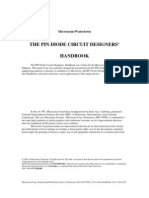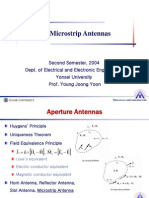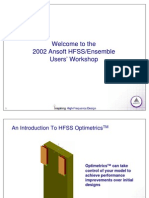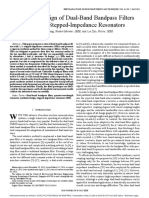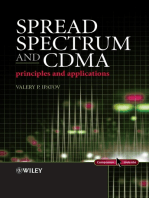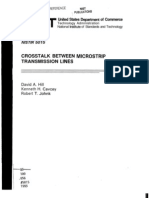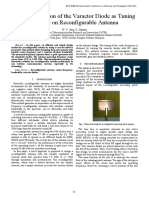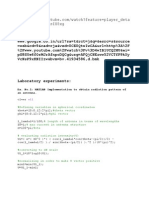Lecture 524 12 SIW
Lecture 524 12 SIW
Uploaded by
KateXX7Copyright:
Available Formats
Lecture 524 12 SIW
Lecture 524 12 SIW
Uploaded by
KateXX7Copyright
Available Formats
Share this document
Did you find this document useful?
Is this content inappropriate?
Copyright:
Available Formats
Lecture 524 12 SIW
Lecture 524 12 SIW
Uploaded by
KateXX7Copyright:
Available Formats
SIW-1
SUBSTRATE INTEGRATED WAVEGUIDES
Substrate integrated waveguides belong to the family of substrate integrated circuits.
Substrate Integrated Circuits (SICs):
Substrate Integrated Waveguide (SIW)
Substrate Integrated Non-Radiative Dielectric Waveguide
(SINRDW)
Substrate Integrated Image Guide (SIIG)
Plated-through
(metallized) via holes
Air holes
Air holes
SIW-2
In the upper microwave and the lower millimeter-wave range, substrate-integrated waveguide circuits
form a reasonable compromise between microstrip and waveguide technologies.
Microstrip is light weight and
compact but has high ohmic losses.
Waveguide has low ohmic losses but
is bulky and difficult to integrate.
Substrate-integrated waveguide uses the top and bottom metallizations of the substrate
and metallized via holes to create an artificial waveguide.
SIW-3
Fundamental Mode Propagation in
Regular Waveguide Substrate Integrated Waveguide
SIW is a compromise between microstrip and all-metal waveguide
SIW-4
1. DESIGN OF VIA DIAMETER AND VIA SEPARATION
Leakage loss in Np/rad as a function of via
diameter and via separation normalized to the
cutoff wavelength.
Deslandes, Wu, IEEE Trans. MTT, J une 2006
SIW circuits with d/p between 0.4 and 0.8 have been
published. In order to limit leakage losses to those of
dielectric and conductors, d/p>0.5 is recommended.
SIW-5
2. EQUIVALENT WAVEGUIDE WIDTH
The equivalent waveguide width determines the SIWs cutoff frequency (cutoff wavelength) for applying
rectangular waveguide design procedures.
equ
c r
c
a
2f
=
c
Design an SIW circuit for a given frequency (waveguide
band). Note that only TEm0 modes can propagate in SIW.
c is the speed of light
Different models to calculate the equivalent waveguide width:
2
equ
d
a a
0.95p
=
Model (1) (Cassivi et al, IEEE MWCL, Sep. 2002):
Model (2) (Yan et al, IEEE MWCL, Sep. 2004):
1 2 3
equ 1 2
3 1
x x x p
a a x x
d x x
(
| |
+
= + +
( |
\ .
( )
( )
( )
1
2
3
x 1.0198 0.3465 a p 1.0684
x 0.1183 1.2729 a p 1.2010
x 1.0082 0.9163 a p 0.2152
= +
=
= +
Model (3) (Xu, Wu, IEEE Trans. MTT, J an. 2005):
2 2
equ
a a 1.08d p 0.1d a = +
Model (4) (Che et al, IET MAP, Feb. 2008):
equ
equ
2a
p p
a arcctg ln
4a 2d
(
t
=
(
t
(
Model (5) (Salehi, Mehrshahi, IEEE MWCL, J an. 2011):
equ
3
2
2
4
a
a
2a d d 4a d
1
p a d a d
5p
=
| |
| |
| |
+
|
| |
|
\ .
\ .
\ .
SIW-6
d/p=0.4: Models (1), (2), (3), (5)
d/p=0.6: Model (2) Models (1), (3), (5)
d/p=0.8: Models (1), (3) Models (2), (5)
SIW-7
3. SQUARE-TO-CIRCULAR VIA CONVERSION
When the via holes are produced by a laser, they can have any shape. Square via holes can be fabricated
closer together than circular ones. Square via holes are also easier to model, e.g., in MMT, FEM, etc
W-band SIW-to-waveguide transition with square via holes (Dousset, Wu, Claude, El. Lett., Nov. 2010)
The side length of the square via is the arithmetic mean of the inscribed and circumscribed squares of the
circular via:
1
1
2 2
2
o i
a a d
a
+ | |
= = +
|
\ .
SIW-8
Examples:
Two-resonator K-band SIW post filter
Four-resonator K-Band SIW dual-band filter
SIW-9
Examples (contd):
K-band SIW 2-way power divider
K-band SIW 3-way power divider
24-slot 3 dB W-band SIW aperture coupler
realized by cascading two 8.34 dB couplers
SIW-10
4. DESIGN OF SIW COMPONENTS
- For given frequency range, select substrate material and determine via-hole diameter and
separation.
- Design the component in all-dielectric-filled rectangular waveguide (H-plane technology)
using the equivalent waveguide width.
- Set certain parameters (iris thickness, coupling aperture thickness, etc) to via-hole
dimensions so that they can easily be replaced by via holes later.
- Optimize the rectangular waveguide component for given specifications.
- Replace waveguide walls by via holes using the equivalent waveguide-to-SIW width and use
all-dielectric waveguide ports.
- Use square via holes if that is easier to handle in modelling procedures (MMT,
WaveWizard, FEM, etc).
- Fine-optimize the SIW component.
- Verify with a different field solver.
- Include microstrip-to-SIW tapers for measurements.
- Design calibration standards.
SIW-11
5. PRACTICAL EXAMPLES OF SIW TECHNOLOGY
Power Dividers (Germain, Deslandes, Wu, CCECE 2003)
SIW-12
Couplers (Cassivi, Deslandes, Wu, APMC 2002)
SIW-13
Filters (Chen, Wu, Drolet, IEEE Trans. MTT, Mar 2009)
Fourth-order filter with three oversized SIW
cavities
Fourth-order filter with two oversized SIW
cavities
SIW-14
Filters contd (Chen, Wu, Li, IEEE Trans. MTT, Dec 2007)
K-band SIW dual-band filter
K-band SIW triple-band filter
SIW-15
Di/Triplexers
Ka-band SIW diplexer (Tang Hong Chen Luo Wu,
IEEE Trans. MTT, Apr 2007)
2 GHz SIW triiplexer (Hou, Hong, Tian, Liu, Tang,
APMC, Dec 2009)
SIW-16
Leakage waves
Leaky Wave Antenna
Slot Array Antenna
Antipodal Linearly
Tapered Slot Antenna (ALTSA)
Antenna Applications
SIW-17
Antenna coupled diplexer (D. Deslandes,
PhD Diss, Ecole Polytechnique, Montreal,
2005)
SIW-18
10 GHz ALTSA Array (Hao, Hong, Chen,Chen,
Wu, IEEE MTT-S IMS, J une 2005)
Top metallization
Bottom metallization
SIW-19
37.5 GHz Multibeam Antenna with Parabolic Reflector
(Cheng, Hong, Wu, IEEE Trans. AP, J an 2008)
SIW-20
Radiation pattern when excited at Port 1
Radiation pattern when excited at Port 3
94 GHz Monopulse Array (Cheng, Hong, Wu,
IEEE Trans. AP, J an 2012)
You might also like
- Introduction to Optical Waveguide Analysis: Solving Maxwell's Equation and the Schrödinger EquationFrom EverandIntroduction to Optical Waveguide Analysis: Solving Maxwell's Equation and the Schrödinger EquationNo ratings yet
- Optical and Microwave Technologies for Telecommunication NetworksFrom EverandOptical and Microwave Technologies for Telecommunication NetworksNo ratings yet
- Butler MatrixDocument32 pagesButler MatrixamgadadelNo ratings yet
- Patch Antenna Design With MATLABDocument8 pagesPatch Antenna Design With MATLABMohit Kumar SinghNo ratings yet
- Microwave Filter DesignDocument106 pagesMicrowave Filter Designgirinaag10No ratings yet
- 4 1 2 Uwb Antenne Simulation With CST Microwave StudioDocument24 pages4 1 2 Uwb Antenne Simulation With CST Microwave StudioUmair SaleemNo ratings yet
- Substrate Integrated Waveguide (SIW) Techniques: The State-of-the-Art Developments and Future TrendsDocument23 pagesSubstrate Integrated Waveguide (SIW) Techniques: The State-of-the-Art Developments and Future TrendsclanonNo ratings yet
- Panel Antenna PPT - Akash RayDocument19 pagesPanel Antenna PPT - Akash RayOwen HolmesNo ratings yet
- P-I-N Diode HandbookDocument137 pagesP-I-N Diode HandbookChangjian LiNo ratings yet
- FMCW PrincipeDocument21 pagesFMCW PrincipeTom GNo ratings yet
- FMCW Radar Is A Special Type of Radar Sensor Which Radiates: Frequency-Modulated Continuous-Wave RadarDocument8 pagesFMCW Radar Is A Special Type of Radar Sensor Which Radiates: Frequency-Modulated Continuous-Wave RadarSummer KoNo ratings yet
- OFDM Basics TutorialDocument3 pagesOFDM Basics Tutorialhisoni85100% (1)
- Antennas PDFDocument2 pagesAntennas PDFwaytelaNo ratings yet
- Design of A 24GHz Rectangular Microstrip Patch Antenna For Wireless ApplicationsDocument7 pagesDesign of A 24GHz Rectangular Microstrip Patch Antenna For Wireless ApplicationsIJRASETPublicationsNo ratings yet
- EDICONChina2019 - (87) - Vye, David - Designing A Narrowband 28-GHz Bandpass Filter For 5G Applications PDFDocument41 pagesEDICONChina2019 - (87) - Vye, David - Designing A Narrowband 28-GHz Bandpass Filter For 5G Applications PDFkhyatichavdaNo ratings yet
- Antennas: Phil U. Lomboy, EceDocument161 pagesAntennas: Phil U. Lomboy, EcePiel MercadoNo ratings yet
- 2.microwave Engineering PDFDocument82 pages2.microwave Engineering PDFsankeerthanreddyNo ratings yet
- Antenas N Wave PropagationDocument76 pagesAntenas N Wave PropagationMd ZaheerNo ratings yet
- Ridged Horn AntennaDocument4 pagesRidged Horn AntennachmscemNo ratings yet
- Antenna Polarization PDFDocument2 pagesAntenna Polarization PDFJhec AlbaNo ratings yet
- Chapter 01 Fundamental Parameters of AntennaDocument73 pagesChapter 01 Fundamental Parameters of AntennaEngr Nuzhat Lashari100% (1)
- WC2 1Document14 pagesWC2 1shaziaNo ratings yet
- Microstrip Patch AntennaDocument15 pagesMicrostrip Patch AntennaSubhanjali MyneniNo ratings yet
- Antennas L01Document15 pagesAntennas L01Domenico Rizzo100% (1)
- 570914000AntennaArray CST MWS - SimulationDocument9 pages570914000AntennaArray CST MWS - SimulationkaranNo ratings yet
- FilterDesign and HFSS HODocument22 pagesFilterDesign and HFSS HOOlalere KolawoleNo ratings yet
- Design of Aperture Coupled Fed Micro-Strip Patch Antenna For Wireless CommunicationDocument3 pagesDesign of Aperture Coupled Fed Micro-Strip Patch Antenna For Wireless CommunicationALEX_125No ratings yet
- Digital Control Board For Phased Array Antenna Beam Steering in ADocument115 pagesDigital Control Board For Phased Array Antenna Beam Steering in AJaime LazoNo ratings yet
- Micro Strip AntennasDocument26 pagesMicro Strip AntennasAshok RamavathNo ratings yet
- RADAR Probems (Eng)Document51 pagesRADAR Probems (Eng)abd syNo ratings yet
- Design of Pyramidal Horn Antenna For UWB ApplicationsDocument3 pagesDesign of Pyramidal Horn Antenna For UWB ApplicationsAmador Garcia IIINo ratings yet
- High Frequency Structure Simulator (HFSS) Tutorial: Prepared byDocument71 pagesHigh Frequency Structure Simulator (HFSS) Tutorial: Prepared bySabir SankhlaNo ratings yet
- An Introduction To HFSS OptimetricsDocument52 pagesAn Introduction To HFSS OptimetricsdhruvaaaaaNo ratings yet
- Design and Fabrication of A Microstrip Patch AntennaDocument5 pagesDesign and Fabrication of A Microstrip Patch AntennaAjinkya Dnyaneshwar DhumaleNo ratings yet
- Modelling RF Power Amplifiers With DPD Using Matlab White Paper PDFDocument31 pagesModelling RF Power Amplifiers With DPD Using Matlab White Paper PDFAnshul ModiNo ratings yet
- R2 Techniques Remski Hfss TutorialDocument66 pagesR2 Techniques Remski Hfss TutorialCarriceiros TourNo ratings yet
- Phase Shifter TutorialDocument12 pagesPhase Shifter Tutorialsukusporty100% (1)
- A Compact Ultra-Wideband Power Divider With High Isolation 3.1-10.6 GHZDocument2 pagesA Compact Ultra-Wideband Power Divider With High Isolation 3.1-10.6 GHZagmnm1962100% (1)
- Boundary and Excitation Training: February 2003Document30 pagesBoundary and Excitation Training: February 2003Sandrine GallardNo ratings yet
- Microwave Active Circuit Design: 黃凡修 Fan-Hsiu Huang fshuang@mail.cgu.edu.twDocument36 pagesMicrowave Active Circuit Design: 黃凡修 Fan-Hsiu Huang fshuang@mail.cgu.edu.twMinh VuNo ratings yet
- Types of AntennaDocument8 pagesTypes of AntennaHoney Sk100% (1)
- Thesis of Horn-Final - Paper2 PDFDocument32 pagesThesis of Horn-Final - Paper2 PDFవేలుసామి లింగాసామి0% (1)
- Types of Beamforming: Adaptive AntennasDocument33 pagesTypes of Beamforming: Adaptive AntennasHarryNo ratings yet
- The Gentleman'S Guide To Frequency Selective SurfacesDocument18 pagesThe Gentleman'S Guide To Frequency Selective Surfacesamitgh88100% (1)
- 790 - 2200 MHZ Base Station Antennas For Mobile CommunicationsDocument186 pages790 - 2200 MHZ Base Station Antennas For Mobile CommunicationsAmit Singh TomarNo ratings yet
- 2.design of Vivaldi Antennas ThesisDocument83 pages2.design of Vivaldi Antennas ThesisAlteea MareNo ratings yet
- Synthesis DesignDocument8 pagesSynthesis DesignChandan RoyNo ratings yet
- A New Planar Marchand BalunDocument4 pagesA New Planar Marchand BalunCARROUCHO62No ratings yet
- Group Report Arduino Radar ShieldDocument12 pagesGroup Report Arduino Radar ShieldMustafa PehlivanNo ratings yet
- Design and Simulation of Rectangular Microstrip Patch Antenna With Triple Slot For X BandDocument10 pagesDesign and Simulation of Rectangular Microstrip Patch Antenna With Triple Slot For X BandIJRASETPublicationsNo ratings yet
- Antenna 5Document30 pagesAntenna 5Frederico MailaNo ratings yet
- Project 14 - Transmission Line Design and Layout in ADS (October 2013)Document15 pagesProject 14 - Transmission Line Design and Layout in ADS (October 2013)Stephen J. WattNo ratings yet
- Global Positioning: Technologies and PerformanceFrom EverandGlobal Positioning: Technologies and PerformanceRating: 5 out of 5 stars5/5 (1)
- Radio Spectrum Management: Policies, Regulations and TechniquesFrom EverandRadio Spectrum Management: Policies, Regulations and TechniquesNo ratings yet
- Bahl - RF and Microwave Coupled-Line CircuitsDocument24 pagesBahl - RF and Microwave Coupled-Line CircuitsKateXX7No ratings yet
- Polyharmonic Distortion Modeling - Verspecht 2006Document14 pagesPolyharmonic Distortion Modeling - Verspecht 2006KateXX7No ratings yet
- X-Parameters Characterization Modeling and Design of Nonlinear RF and Microwave Components - Root PDFDocument238 pagesX-Parameters Characterization Modeling and Design of Nonlinear RF and Microwave Components - Root PDFKateXX7No ratings yet
- 2016 MMM New OrleansDocument351 pages2016 MMM New OrleansKateXX7No ratings yet
- Ch13 FR MEMS Theory, Design, and Technology by RebeizDocument46 pagesCh13 FR MEMS Theory, Design, and Technology by RebeizKateXX7No ratings yet
- Modern Antenna Handbook - CH Spiral Antennas by BalanisDocument13 pagesModern Antenna Handbook - CH Spiral Antennas by BalanisKateXX7No ratings yet
- FAL (2019-20) - ECE3002 - TH - 135 - AP2019201000813 - Reference Material I - Design of Inset Feed - Microstrip AntennaDocument6 pagesFAL (2019-20) - ECE3002 - TH - 135 - AP2019201000813 - Reference Material I - Design of Inset Feed - Microstrip AntennaSai Sudhir VhNo ratings yet
- Microstrip Antenna PDFDocument4 pagesMicrostrip Antenna PDFTDMA2009No ratings yet
- Crosstalk Between Microstrip Transmission Lines: United States Deparbnent of CommerceDocument36 pagesCrosstalk Between Microstrip Transmission Lines: United States Deparbnent of CommerceJohn Paul Torres AbarcaNo ratings yet
- Design of Microstrip Low Pass Filter With Defected Ground StructureDocument4 pagesDesign of Microstrip Low Pass Filter With Defected Ground StructureVivek KushwahNo ratings yet
- Design of A Rectangular Spiral Antenna ForDocument5 pagesDesign of A Rectangular Spiral Antenna ForRenato Silveira FeitozaNo ratings yet
- The Investigation of The Varactor Diode As Tuning Element On Reconfigurable AntennaDocument2 pagesThe Investigation of The Varactor Diode As Tuning Element On Reconfigurable AntennaTayyabNo ratings yet
- Lab ManualDocument29 pagesLab ManualAnantharam RaoNo ratings yet
- Cmos Low Noise Amplifier Design For Microwave and Mmwave ApplicationsDocument29 pagesCmos Low Noise Amplifier Design For Microwave and Mmwave ApplicationsAkhendra KumarNo ratings yet
- Bow Tie Microstrip Antenna DesignDocument5 pagesBow Tie Microstrip Antenna DesignMU Strongest ChannelNo ratings yet
- Simbeor TutorialsDocument163 pagesSimbeor Tutorialshmquan.tkNo ratings yet
- Design and Simulation of E-Shape Microstrip Patch Antenna For Wideband ApplicationsDocument6 pagesDesign and Simulation of E-Shape Microstrip Patch Antenna For Wideband ApplicationshosseinNo ratings yet
- Dual PolarizedDocument3 pagesDual PolarizedSwatilekha ChowdhuryNo ratings yet
- Frequency Selective Surface Textile Antenna For Wearable ApplicationsDocument14 pagesFrequency Selective Surface Textile Antenna For Wearable ApplicationsJOOHI GARGNo ratings yet
- Microstip Vs StriplineDocument4 pagesMicrostip Vs StriplineOana BuzatuNo ratings yet
- Ultra Wideband Antenna With WLAN Band-Notch Characteristic: September 2013Document6 pagesUltra Wideband Antenna With WLAN Band-Notch Characteristic: September 2013Engr Kashi YousafzaiNo ratings yet
- TechnicalDocument295 pagesTechnicalTeresa PerezNo ratings yet
- Antenne MicrostripDocument8 pagesAntenne MicrostripmahdialiiNo ratings yet
- Microwave (Low-Pass and Band-Pass) Filter Design Using Transmission LinesDocument64 pagesMicrowave (Low-Pass and Band-Pass) Filter Design Using Transmission LinesMomenul HoqueNo ratings yet
- Ultra-Wideband Microstrip-Line Bandpass Filters With Good Out-of-Band Performance Using EBG-Embedded Multiple-Mode ResonatorDocument4 pagesUltra-Wideband Microstrip-Line Bandpass Filters With Good Out-of-Band Performance Using EBG-Embedded Multiple-Mode ResonatorShrutiAwasthiNo ratings yet
- Syllabus of 7th SemesterDocument9 pagesSyllabus of 7th SemesterRahul.S.NairNo ratings yet
- Substrate Integrated Waveguide (SIW) Techniques: The State-of-the-Art Developments and Future TrendsDocument23 pagesSubstrate Integrated Waveguide (SIW) Techniques: The State-of-the-Art Developments and Future TrendsclanonNo ratings yet
- 08 Design of 8 X 8 Microstrip Planar Array Antenna For Satellite CommunicationDocument7 pages08 Design of 8 X 8 Microstrip Planar Array Antenna For Satellite CommunicationScott WiederholdNo ratings yet
- Regulation - 2010: K.S.Rangasamy College of Technology, Tiruchengode - 637 215Document3 pagesRegulation - 2010: K.S.Rangasamy College of Technology, Tiruchengode - 637 215Latta SakthyyNo ratings yet
- 11L WaveguidesDocument52 pages11L WaveguidesGiovanni LorchaNo ratings yet
- EC8651-Transmission Lines and RF Systems - 04 - by WWW - LearnEngineering.inDocument112 pagesEC8651-Transmission Lines and RF Systems - 04 - by WWW - LearnEngineering.inNivethaNo ratings yet
- Poster ReserchDocument1 pagePoster ReserchSnehasis HotaNo ratings yet
- Title: Experiment NODocument19 pagesTitle: Experiment NOSI ButtNo ratings yet
- Theory and Experiment On Microstrip AntennasDocument9 pagesTheory and Experiment On Microstrip AntennasFabian VazquezNo ratings yet
- FINALDocument57 pagesFINALSai kumarNo ratings yet
- A Group of RF Design Antenna Microwave Training SystemDocument14 pagesA Group of RF Design Antenna Microwave Training SystemMbah GoogleNo ratings yet










